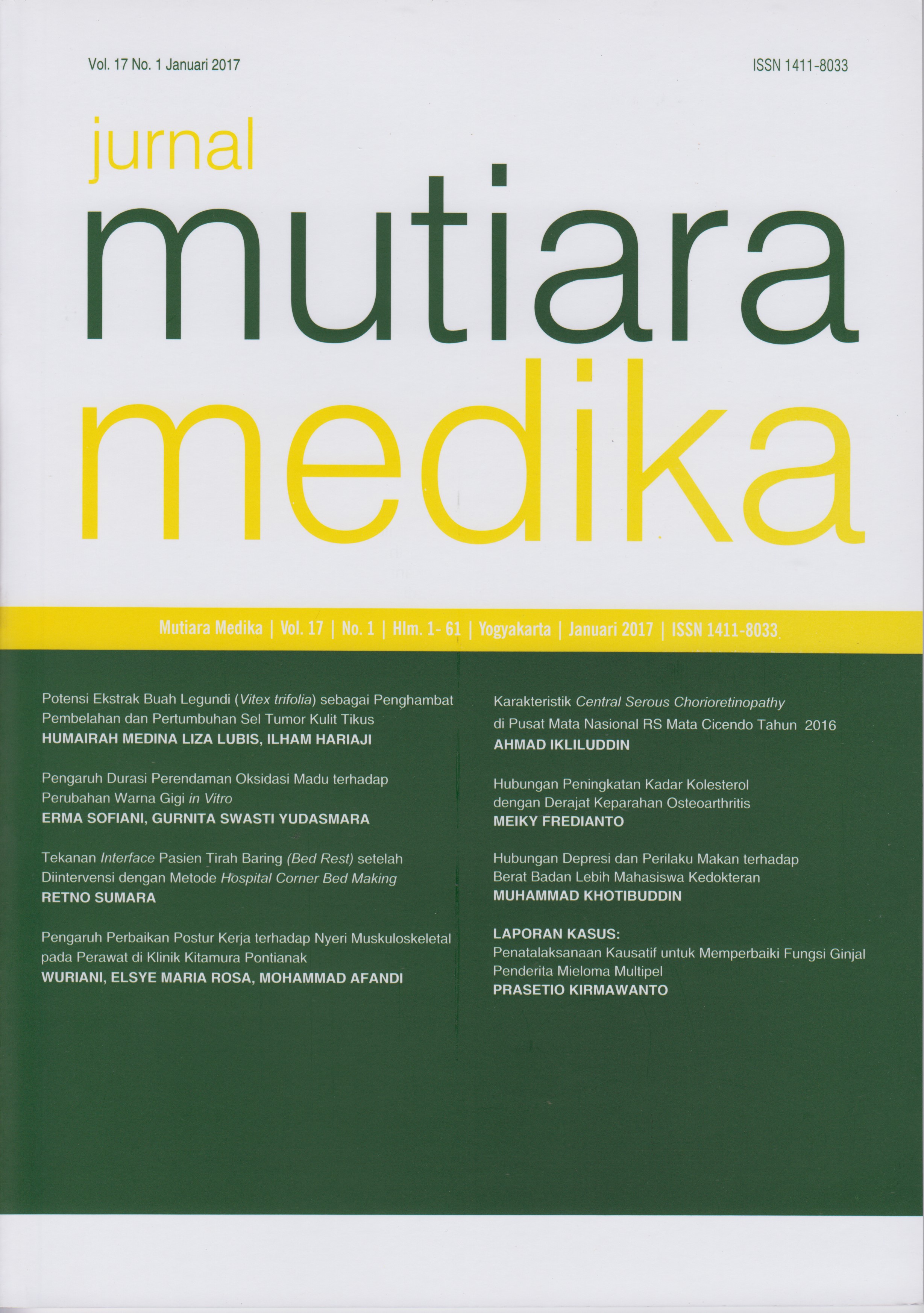Ekstrak Buah Legundi (Vitex trifolia) Mampu Menghambat Pembelahan dan Pertumbuhan Sel Tumor Kulit Tikus
DOI:
https://doi.org/10.18196/mmjkk.v17i1.3676Keywords:
tumor kulit, benzoalphapyrene, buah legundi (Vitex trifolia), aktivitas proliferasi dan pertumbuhan, skin tumor, legundi fruit (Vitex trifolia), proliferation and growth activityAbstract
Dengan perubahan gaya hidup manusia yang tidak sehat, terpapar radiasi sinar ultraviolet, agen fisika dan kimia secara berlebihan, luka yang lama tidak sembuh khususnya luka bakar dan infeksi virus, yang apabila dibiarkan dan tidak diobati bisa berkembang menjadi kanker. Pengobatan untuk tumor lebih banyak menggunakan obat-obatan sintetik yang juga dapat menimbulkan komplikasi dan kebanyakan belum menunjukkan hasil yang memuaskan, sehingga banyak penelitian ditujukan pada tanaman tradisional yang banyak tumbuh di Indonesia. Tujuan penelitian ini adalah untuk mengetahui potensi penghambat pembelahan sel dari ekstrak buah legundi (Vitex trifolia). Penelitian ini adalah studi eksperimental dengan menggunakan tikus Wistar yang dibagi dalam 5 kelompok yaitu kelompok kontrol normal (K1), kontrol positif (K2), P1, P2, P3. Ekstrak etanol buah V. trifolia dibagi dalam 2 dosis yaitu 0,5g dan 1g/kgBB/hari/oral selama 3 minggu. Hasil penelitian berupa 3 slide (60%) adalah tumor ganas (nonkeratinizing squamous cellcarcinoma), 1 slide (20%) adalah lesi atipik dan 1 slide (20%) adalah lesi jinak. Setelah pemberian terapi menggunakan buah V. trifolia, kelompok 2, 3, dan 4 yang memiliki lesi tumor mengalami penurunan ukuran (mengecil). Disimpulkan bahwa ekstrak etanol buah V. trifolia memiliki kemampuan untuk menginhibisi aktivitas proliferasi dan pertumbuhan dengan dosis pemberian 0,5 g dan 1 gr/hari.
References
Buljan, M., Bulana, V, Stanic, S. Variation in Clinical Presentation of Basal Cell Carcinoma. University Department of Dermatology and Venereology Zagreb Croatia. 2008; 25-30.
Kumar, V., Cotran S. R., Robbins L. St. Robbins Basic Pathology. 8th Edition. W.B Saunders Company. Philadelphia. Pennsylvania. 2007; 307: 1244-46.
Nair, A.G.R., Ramesh, P. and Subramanian, S. Two unusual flavones (artemetin and 7-desmethyl artemetin) from the leaves of V. trifolia., Curr. Sci., 1975; 44 (7) : 214–216.
Vedantham, T.N.C. and Subramanian, S.S. Non-flavonoid components of V. trifolia.,Indian J. Pharmacol., 1976; 38 (1) : 13.
Ramesh, P., Nair, A.G.R. and Subramanian, S.S. Flavone glycosides of V. trifolia. Fitoterapia, LVII 4, 1986; pp. 282–283.
Zeng, X., Fang, Z., Wu, Y., Zhang, H. Chemical constituents of the fruits of V. trifolia. Zhongguo Zhong Yao Za Zhi., 1996; 21(3):167-168, 191.
Herna´ndez, M.M., Heraso, C., Villarreal, M.L., Vargas-Arispuro, Aranda, E., 1999, Biological activities of crude plant extracts from Vitex trifolia L. (Verbenaceae), J. of Ethnopharmacol., 67 : 37–44.
Li, W.X., Cui, C.B., Cai, B., Yao, X.S. Labdanetype diterpenes as new cell cycle inhibitors and apoptosis inducers from V. trifolia, J Asian Nat Prod Res., 2005; 7(2) : 95-105.
Mustanir dan Rosnani. 2008. Isolasi Senyawa Bioaktif Penolak (Repellent) Nyamuk Dari Ekstrak Aseton Batang Tumbuhan Legundi (Vitex trifolia). Bul. Littro. Vol. XIX No. 2 : 174-180.
Junqueira, LC & Carneiro, J. Basic Histology Text and Atlas (10th ed.). United States of America: The McGraw-Hill Companies, Inc. 2007. Hal:372-378.
Mahardini, T., Renawati., Yulistia, A, Parameter Polycyclic Aromatic Hydrocarbons (PAHs) dalam Standarisasi Produk Pangan. Balai Besar Industri Agro Deprin, Bogor.
Downloads
Issue
Section
License
Copyright
Authors retain copyright and grant Mutiara Medika: Jurnal Kedokteran dan Kesehatan (MMJKK) the right of first publication with the work simultaneously licensed under an Attribution 4.0 International (CC BY 4.0) that allows others to remix, adapt and build upon the work with an acknowledgment of the work's authorship and of the initial publication in Mutiara Medika: Jurnal Kedokteran dan Kesehatan (MMJKK).
Authors are permitted to copy and redistribute the journal's published version of the work (e.g., post it to an institutional repository or publish it in a book), with an acknowledgment of its initial publication in Mutiara Medika: Jurnal Kedokteran dan Kesehatan (MMJKK).
License
Articles published in the Mutiara Medika: Jurnal Kedokteran dan Kesehatan (MMJKK) are licensed under an Attribution 4.0 International (CC BY 4.0) license. You are free to:
- Share — copy and redistribute the material in any medium or format.
- Adapt — remix, transform, and build upon the material for any purpose, even commercially.
This license is acceptable for Free Cultural Works. The licensor cannot revoke these freedoms as long as you follow the license terms. Under the following terms:
Attribution — You must give appropriate credit, provide a link to the license, and indicate if changes were made. You may do so in any reasonable manner, but not in any way that suggests the licensor endorses you or your use.
- No additional restrictions — You may not apply legal terms or technological measures that legally restrict others from doing anything the license permits.






